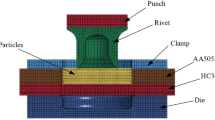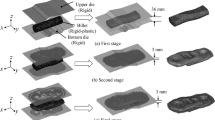Abstract
The coupler knuckle of railway wagon is a complex forging component with big section change. In this paper, a near-net-shape forming process for coupler knuckle based on closed-die forging without flash was proposed and the preforming operation was designed and optimized. Firstly, the shape and the dimension of the preforging were preliminarily designed based on the geometric features of forged knuckle and the flow characteristics of metal in the forging process, and then a multi-objective optimization approach based on the filling capacity, deformation homogeneity, and damage degree of forgings was established, and the response surface method combined with the finite element simulation was used to obtain the optimum geometric parameters of preforging. In order to verify the effectiveness of the near-net-shape forming process and the optimized results on preform design, forming experiments and measurements were carried out; the analyzed results show that based on the designed preforging, near-net-shape forming process is capable of producing coupler knuckle of high quality and without forming defect.














Similar content being viewed by others
References
Hino R, Sasaki A, Yoshida F, Toropov VV (2008) A new algorithm for reduction of number of press-forming stages in forging processes using numerical optimization and FE simulation. Int J Mech Sci 50(5):974–983
Khalilpourazary S, Dadvand A, Azdast T, Sadeghi MH (2011) Design and manufacturing of a straight bevel gear in hot precision forging process using finite volume method and CAD/CAE technology. Int J Adv Manuf Technol 56(1-4):87–95
Chan WL, Fu MW, Lu J, Chan LC (2009) Simulation-enabled study of folding defect formation and avoidance in axisymmetrical flanged components. J Mater Process Technol 209(11):5077–5086
Sheu JJ, Yu CH (2009) Preform and forging process designs based on geometrical features using 2D and 3D FEM simulations. Int J Adv Manuf Technol 44(3-4):244–254
Sun WY, Chen L, Zhang TL et al (2018) Preform optimization and microstructure analysis on hot precision forging process of a half axle flange. Int J Adv Manuf Technol 95(5/8):2157–2167
Zhang DW, Yang H (2013) Preform design for large-scale bulkhead of TA15 titanium alloy based on local loading features. Int J Adv Manuf Technol 67(9-12):2551–2562
Lee SR, Lee YK, Park CH, Yang DY (2002) A new method of preform design in hot forging by using electric field theory. Int J Mech Sci 44(4):773–792
Kong TF, Chan LC, Lee TC (2008) Numerical and experimental investigation of preform design in non-axisymmetric warm forming. Int J Adv Manuf Technol 37(9-10):908–919
Lu B, Ou H, Cui ZS (2011) Shape optimisation of preform design for precision close-die forging. Struct Multidiscip O 44(6):785–796
Knust J, Podszus F, Stonis M, Begrens B, Overmeyer L, Ullmann G (2017) Preform optimization for hot forging processes using genetic algorithms. Int J Adv Manuf Technol 89(5-8):1623–1634
Poshal G, Ganesan P (2008) An analysis of formability of aluminium preforms using neural network. J Mater Process Technol 205(1-3):272–282
Zhao XH, Zhao GQ, Wang GC, Wang TH (2002) Preform die shape design for uniformity of deformation in forging based on preform sensitivity analysis. J Mater Process Technol 128(1-3):25–32
Tang YC, Zhou XH, Chen J (2008) Preform tool shape optimization and redesign based on neural network response surface methodology. Finite Elem in Anal Des 44(8):462–471
Wei K, Zhan M, Fan XG, Yang H, Gao PF, Meng M (2018) Unequal-thickness billet optimization in transitional region during isothermal local loading forming of Ti-alloy rib-web component using response surface method. Chin J Aeronaut 31(04):845–859
Yang YH, Liu D, He ZY, Luo ZJ (2010) Optimization of preform shapes by RSM and FEM to improve deformation homogeneity in aerospace forgings. Chin J Aeronaut 23(2):260–267
Gagliardi F, Ciancio C, Ambrogio G (2018) Optimization of porthole die extrusion by Grey-Taguchi relational analysis. Int J Adv Manuf Technol 94(1-4):719–728
He XM (2011) Effects of manipulator compliant movements on the quality of free forgings based on FEM simulation. Int J Adv Manuf Technol 56(9-12):905–913
Torabi SHR, Alibabaei S, Bonab BB et al (2017) Design and optimization of turbine blade preform forging using RSM and NSGA II. J Intell Manuf 28(6):1409–1419
Ceretti E, Lucchi M, Altan T (1999) FEM simulation of orthogonal cutting: serrated chip formation. J Mater Process Technol 95(1-3):17–26
Quan G, Wang F, Liu Y, Shi Y, Zhou L (2013) Evaluation of varying ductile fracture criterion for 7075 aluminum alloy. T Nonferr Metal Soc 23(3):749–755
Zhu F, Wang Z, Lv M (2016) Multi-objective optimization method of precision forging process parameters to control the forming quality. Int J Adv Manuf Technol 83(9-12):1763–1771
Nam YS, Jeon U, Yoon HK, Shin BC, Byun JH (2016) Use of response surface methodology for shot peening process optimization of an aircraft structural part. Int J Adv Manuf Technol 87(9-12):2967–2981
da Silva LC, da Mota PR et al (2016) Burr height minimization using the response surface methodology in milling of PH 13-8 Mo stainless steel. Int J Adv Manuf Technol 87(9-12):3485–3496
Funding
The authors received financial support provided by the National Science Foundation of China (Grant Nos. 51575231 and 51975248).
Author information
Authors and Affiliations
Corresponding authors
Additional information
Publisher’s note
Springer Nature remains neutral with regard to jurisdictional claims in published maps and institutional affiliations.
Rights and permissions
About this article
Cite this article
Meng, FX., Cai, ZY. & Chen, QM. Multi-objective optimization of preforming operation in near-net shape forming of complex forging. Int J Adv Manuf Technol 105, 4359–4371 (2019). https://doi.org/10.1007/s00170-019-04539-8
Received:
Accepted:
Published:
Issue Date:
DOI: https://doi.org/10.1007/s00170-019-04539-8




